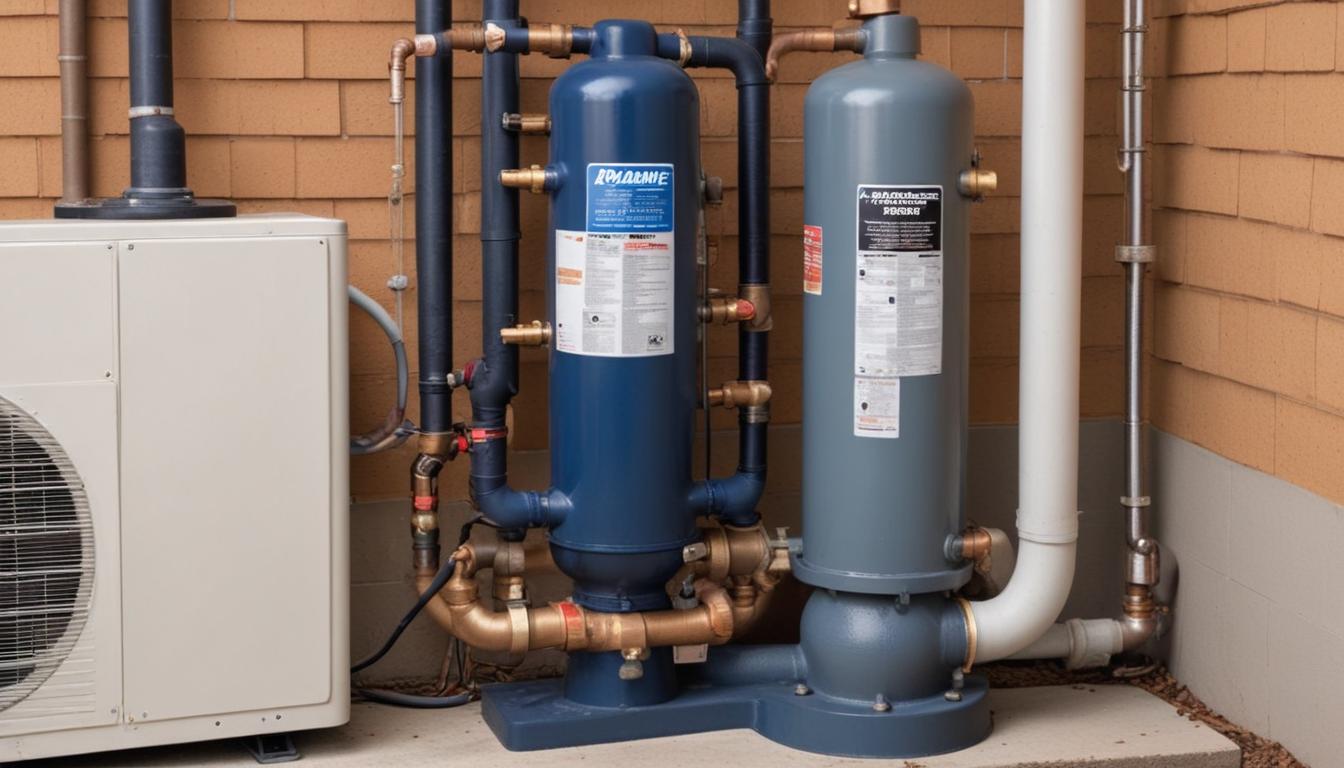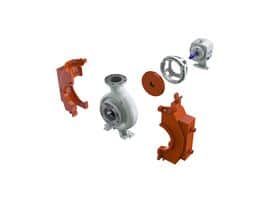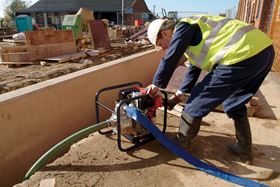how to choose the right pump for your HVAC system
To ensure effective and reliable performance of your HVAC system, a thorough assessment of its specific requirements is essential. This foundational step in HVAC pump selection involves understanding various factors that influence the choice of the right pump for your setup.
Key Factors to Consider:
- System Capacity: Determine the overall capacity of your HVAC system, including heating and cooling loads, to ensure the pump can handle the required volume.
- Fluid Type: Identify the type of fluid being circulated, whether it’s water, glycol mixtures, or other refrigerants, as different pumps are designed for specific fluids.
- Operating Environment: Consider the installation environment, including space constraints, temperature ranges, and potential exposure to corrosive elements.
- Integration with Existing Components: Assess how the pump will integrate with other system components such as boilers, chillers, and heat exchangers.
System Specifications Table:
| Specification | Description |
|---|---|
| Flow Rate | Measure of the volume of fluid the pump needs to circulate, typically expressed in gallons per minute (GPM) or liters per second (L/s). |
| Pressure Requirements | Determines the head pressure the pump must generate to overcome system resistance, usually measured in feet or meters of head. |
| Power Supply | Specifications of the electrical supply available, including voltage, phase, and frequency, to ensure compatibility with the pump’s motor. |
| Efficiency Standards | Energy efficiency ratings and compliance with relevant standards to minimize operational costs and environmental impact. |
Steps to Assess Your HVAC System’s Requirements:
- Evaluate the Heating and Cooling Loads: Calculate the BTU (British Thermal Units) required for heating and cooling to determine the necessary pump capacity.
- Determine the System Layout: Map out the piping configuration, distances, and elevation changes to understand the flow dynamics and pressure needs.
- Identify Peak Flow Conditions: Analyze peak usage scenarios to ensure the pump can handle maximum demand without performance issues.
- Assess Redundancy Needs: Decide if a single pump or multiple pumps are needed for backup and reliability purposes.
- Review Maintenance Requirements: Consider the ease of access for maintenance and the availability of replacement parts to ensure long-term sustainability.
By meticulously evaluating these aspects, you can make informed decisions that align with your HVAC system’s demands, ensuring optimal performance and longevity.
understand different pump types
Selecting the appropriate pump type is a critical aspect of HVAC pump selection, as each type offers unique advantages tailored to specific system requirements. Understanding the various pump types available allows you to make an informed decision that ensures optimal performance and efficiency of your HVAC system.
Common Pump Types Used in HVAC Systems:
- Centrifugal Pumps: These are the most widely used pumps in HVAC applications due to their simplicity and reliability. They operate by converting rotational kinetic energy into hydrodynamic energy, efficiently moving large volumes of fluid.
- Positive Displacement Pumps: Suitable for applications requiring precise flow control, these pumps move fluid by trapping a fixed amount and forcing it through the system. They are ideal for handling viscous fluids or systems with variable flow rates.
- Turbine Pumps: Designed for high-pressure applications, turbine pumps are compact and capable of handling fluids containing suspended solids, making them appropriate for certain specialized HVAC systems.
- Submersible Pumps: These pumps are installed directly within the fluid they are intended to move, which helps reduce noise and vibration. They are often used in confined spaces where space optimization is essential.
Comparison of Pump Types:
| Pump Type | Advantages | Disadvantages | Typical Applications |
|---|---|---|---|
| Centrifugal Pumps | High flow rates, simple design, low maintenance | Less effective for high-viscosity fluids, requires priming | Large HVAC systems, water circulation, cooling towers |
| Positive Displacement Pumps | Precise flow control, handles viscous fluids | Lower flow rates, potential for pulsation | Variable flow HVAC systems, chilled water applications |
| Turbine Pumps | Compact size, high-pressure capabilities | Limited flow rates, sensitive to fluid composition | Specialized HVAC systems, high-pressure zones |
| Submersible Pumps | Quiet operation, space-saving installation | Complex maintenance, potential for electrical issues | Confined HVAC spaces, integrated fluid systems |
Factors to Consider When Choosing a Pump Type:
- Fluid Characteristics: Assess the viscosity, temperature, and presence of particulates in the fluid to determine the most suitable pump type.
- Flow Rate Requirements: Match the pump’s flow rate capabilities with the system’s demand to ensure efficient operation without overloading.
- Pressure Needs: Evaluate the head pressure the pump must overcome, selecting a type that can reliably meet these requirements.
- Energy Efficiency: Consider the energy consumption of each pump type to minimize operational costs and enhance sustainability.
- Maintenance and Durability: Choose pumps that offer ease of maintenance and are built to withstand the operating environment for longevity.
By thoroughly understanding the different pump types and their respective attributes, you can select the right pump that aligns with your HVAC system’s specific needs, ensuring both performance and efficiency.
calculate flow and pressure needs
Accurately determining the flow rate and pressure requirements of your HVAC system is crucial for selecting a pump that ensures optimal performance and reliability. These parameters dictate the pump’s ability to circulate the necessary volume of fluid while overcoming the inherent resistance within the system.
Understanding Flow Rate
Flow rate refers to the volume of fluid that must be moved through the HVAC system within a specific time frame, typically measured in gallons per minute (GPM) or liters per second (L/s). An accurate flow rate ensures that your system can adequately heat or cool the designated space without overburdening the pump or causing inefficiencies.
Calculating Flow Rate:
- Identify the Total Heat Load: Determine the total heating and cooling load of the space, usually expressed in British Thermal Units (BTUs) per hour.
- Use the Flow Rate Formula:
Formula Description Flow Rate (GPM) = BTU/hr ÷ (∆T × 500) Where ∆T is the temperature difference between the supply and return water. - Apply the Formula: For example, if the total heat load is 60,000 BTU/hr and the temperature difference (∆T) is 20°F:
- Flow Rate = 60,000 ÷ (20 × 500) = 6 GPM
Assessing Pressure Requirements
Pressure requirements, often referred to as head pressure, represent the force the pump must generate to move the fluid through the HVAC system against gravitational and frictional forces. It is typically measured in feet of head or meters of head.
Calculating Pressure Needs:
- Determine the Total Head Loss: This includes both static head (due to elevation changes) and dynamic head (resulting from friction within the pipes and components).
- Static Head: Measure the vertical distance the fluid must be lifted.
- Dynamic Head: Calculate the friction loss using the Darcy-Weisbach or Hazen-Williams equations based on pipe length, diameter, flow rate, and pipe roughness.
- Sum the Head Losses: Combine both static and dynamic head losses to determine the total head pressure required.
- For instance, if the static head is 10 feet and the dynamic head is 15 feet, the total head pressure needed is 25 feet.
Example Calculation:
| Parameter | Value | Unit |
|---|---|---|
| Total Heat Load | 80,000 | BTU/hr |
| Temperature Difference (ΔT) | 15 | °F |
| Flow Rate Calculation | 80,000 ÷ (15 × 500) = 10.67 | GPM |
| Static Head | 8 | feet |
| Dynamic Head | 12 | feet |
| Total Head Pressure | 8 + 12 = 20 | feet |
Factors Influencing Flow and Pressure Calculations:
- Pipe Diameter and Length: Larger diameters and shorter lengths reduce resistance, decreasing required pressure.
- Number of Fittings and Valves: Each additional component introduces potential points of friction, increasing pressure needs.
- Fluid Viscosity: Thicker fluids require more energy to circulate, impacting both flow rate and pressure calculations.
- Elevation Changes: Significant vertical distances necessitate higher static head calculations.
- System Configuration: Parallel versus series piping can affect overall flow dynamics and pressure requirements.
By meticulously calculating both flow rate and pressure requirements, you ensure that your HVAC pump selection aligns perfectly with your system’s demands. This precision not only enhances performance but also contributes to the longevity and efficiency of your HVAC infrastructure, ultimately leading to reduced energy consumption and operational costs.
consider energy efficiency
 Energy efficiency is a critical consideration in the selection of an HVAC pump, as it directly impacts both operational costs and the environmental footprint of your system. Prioritizing energy-efficient pumps not only leads to significant cost savings over time but also aligns with sustainable practices and regulatory standards.
Energy efficiency is a critical consideration in the selection of an HVAC pump, as it directly impacts both operational costs and the environmental footprint of your system. Prioritizing energy-efficient pumps not only leads to significant cost savings over time but also aligns with sustainable practices and regulatory standards.
Benefits of Energy-Efficient Pumps:
- Reduced Operational Costs: Energy-efficient pumps consume less electricity, resulting in lower utility bills and improved overall profitability for commercial installations.
- Environmental Impact: Lower energy consumption translates to reduced greenhouse gas emissions, contributing to a more sustainable and eco-friendly operation.
- Enhanced System Performance: Efficient pumps often incorporate advanced technologies that improve reliability, reduce wear and tear, and extend the lifespan of both the pump and the HVAC system.
- Compliance with Standards: Increasingly strict energy regulations and standards necessitate the adoption of energy-efficient equipment to meet legal and certification requirements.
Key Factors to Evaluate Energy Efficiency:
- Energy Efficiency Ratings: Look for pumps with high energy efficiency ratings, such as those certified by ENERGY STAR or other recognized standards. These ratings provide a benchmark for comparing the efficiency of different pump models.
- Variable Frequency Drives (VFDs): Pumps equipped with VFDs can adjust their speed to match the system’s demand, optimizing energy usage and reducing unnecessary power consumption during lower load conditions.
- Motor Efficiency: The efficiency of the pump’s motor plays a significant role in overall energy consumption. High-efficiency motors consume less power while delivering the same performance as standard motors.
- System Integration: An energy-efficient pump should seamlessly integrate with your existing HVAC system, ensuring that all components work harmoniously to maintain optimal performance without wasting energy.
- Maintenance and Operation: Regular maintenance and proper operation of the pump can sustain its efficiency over time. Features such as easy access for maintenance and built-in diagnostics can help maintain high efficiency levels.
Energy Efficiency Comparison:
| Pump Model | Energy Efficiency Rating | Features | Estimated Annual Savings |
|---|---|---|---|
| Model A | ENERGY STAR Certified | VFD, High-efficiency motor | $500 |
| Model B | Premium Efficiency | Smart controls, Integrated diagnostics | $650 |
| Model C | Standard Efficiency | Basic motor, Fixed speed | $300 |
Strategies to Enhance Energy Efficiency:
- Select the Right Pump Size: Oversized pumps can lead to unnecessary energy consumption, while undersized pumps may struggle to meet system demands. Accurate sizing based on your HVAC system’s requirements is essential for optimal efficiency.
- Implement Pump Controls: Advanced control systems, such as smart sensors and automation technologies, can dynamically adjust pump operation to match real-time demand, minimizing energy wastage.
- Optimize System Design: Efficient system design, including proper pipe sizing, minimizing bends and fittings, and reducing friction losses, can enhance overall pump efficiency and reduce the required energy input.
- Regular Maintenance: Keeping the pump and associated components clean and well-maintained ensures that the system operates at peak efficiency, preventing energy losses due to wear, debris, or mechanical issues.
- Upgrade to High-Efficiency Models: When replacing old pumps, opting for the latest high-efficiency models can provide immediate energy savings and improved performance.
Energy Efficiency Standards and Certifications:
Adhering to recognized energy efficiency standards and certifications ensures that the selected pump meets industry benchmarks for performance and sustainability. Some of the key standards include:
- ENERGY STAR: A widely recognized certification that identifies energy-efficient products, helping consumers and businesses make informed decisions that reduce energy consumption.
- ASHRAE Standards: The American Society of Heating, Refrigerating and Air-Conditioning Engineers (ASHRAE) sets industry standards for energy efficiency, promoting best practices in HVAC pump selection and system design.
- IEC Standards: The International Electrotechnical Commission (IEC) provides global standards for the efficiency and performance of electrical and electronic devices, including HVAC pumps.
By carefully considering energy efficiency in your HVAC pump selection, you can achieve significant cost savings, enhance system performance, and contribute to environmental sustainability. Ensuring that your chosen pump aligns with the highest energy standards not only benefits your immediate operational needs but also supports long-term efficiency and reliability of your HVAC infrastructure.
consult with an HVAC professional
Engaging with an experienced HVAC professional is a pivotal step in the HVAC pump selection process. These experts bring a wealth of knowledge and technical expertise that ensure you choose the right pump tailored to your system’s specific needs. Their guidance can mitigate the risks of selecting an incompatible pump, which can lead to inefficiencies, increased energy consumption, and potential system failures.
Advantages of Consulting an HVAC Professional:
- Expert Assessment: Professionals conduct a comprehensive evaluation of your HVAC system, considering factors such as system capacity, existing infrastructure, and operational demands to recommend the most suitable pump type.
- Accurate Calculations: They perform precise flow and pressure calculations, ensuring that the selected pump can handle the required performance metrics without overloading or underperforming.
- Customized Recommendations: Based on your specific requirements, an HVAC professional can suggest pumps with features that enhance efficiency, such as variable frequency drives (VFDs) or high-efficiency motors.
- Compliance and Standards: Professionals ensure that the pump installation adheres to local building codes and industry standards, avoiding potential legal and safety issues.
- Installation and Configuration: Proper installation is crucial for optimal pump performance. HVAC experts handle the setup, configuration, and integration with existing system components to ensure seamless operation.
- Maintenance and Support: Ongoing maintenance services provided by professionals help sustain pump efficiency and longevity, preventing unexpected breakdowns and extending the lifespan of your HVAC system.
Choosing the Right HVAC Professional:
Selecting a qualified HVAC professional is essential for successful pump selection and installation. Consider the following criteria when making your choice:
| Criteria | Description |
|---|---|
| Licensing and Certification | Ensure the professional holds the necessary licenses and certifications, such as those from the Air Conditioning Contractors of America (ACCA) or similar reputable organizations. |
| Experience and Expertise | Look for professionals with extensive experience in HVAC systems and specific knowledge of pump selection and installation. |
| Customer Reviews and References | Check testimonials, reviews, and ask for references to gauge the quality of their work and customer satisfaction levels. |
| Service Offerings | Verify that the professional offers comprehensive services, including assessment, installation, maintenance, and emergency support. |
| Warranty and Guarantees | Choose professionals who provide warranties on their work and the products they install, ensuring reliability and accountability. |
| Cost and Transparency | Obtain detailed quotes and ensure there are no hidden fees. Transparent pricing helps in budgeting and comparing different service providers. |
Key Questions to Ask an HVAC Professional:
Before finalizing your decision, it’s beneficial to ask potential HVAC professionals the following questions to ensure they are the right fit for your project:
- What is your experience with selecting and installing pumps for HVAC systems similar to mine?
- Can you provide references or case studies from previous clients?
- What brands and types of pumps do you recommend, and why?
- How do you calculate the flow and pressure requirements for my system?
- What warranties or guarantees do you offer on your installations?
- Do you provide maintenance and support services post-installation?
- Can you help with energy efficiency assessments and integrations for the new pump?
Collaborating Effectively with Your HVAC Professional:
To maximize the benefits of professional consultation, maintain clear and open communication throughout the process. Share detailed information about your current HVAC setup, operational goals, and any specific concerns you may have. Regularly discuss progress, ask questions, and seek clarification on technical aspects to ensure that the final pump selection aligns perfectly with your requirements.
Cost Considerations:
While professional services incur additional costs, the investment can lead to long-term savings by ensuring optimal pump performance, reducing energy consumption, and minimizing maintenance expenses. Consider the following when evaluating costs:
- Initial Assessment Fees: Some professionals charge for the initial evaluation, which can be offset by the value of their recommendations.
- Installation Costs: Includes labor, materials, and any necessary modifications to your existing system.
- Maintenance Plans: Ongoing maintenance services may be offered as part of a package or on a subscription basis.
- Warranty Coverage: Ensure that warranties cover both parts and labor to protect your investment.
By partnering with a knowledgeable HVAC professional, you ensure that your HVAC pump selection is informed, precise, and tailored to your system’s unique demands. This collaboration not only enhances the performance and efficiency of your HVAC infrastructure but also provides peace of mind through expert guidance and reliable support.




